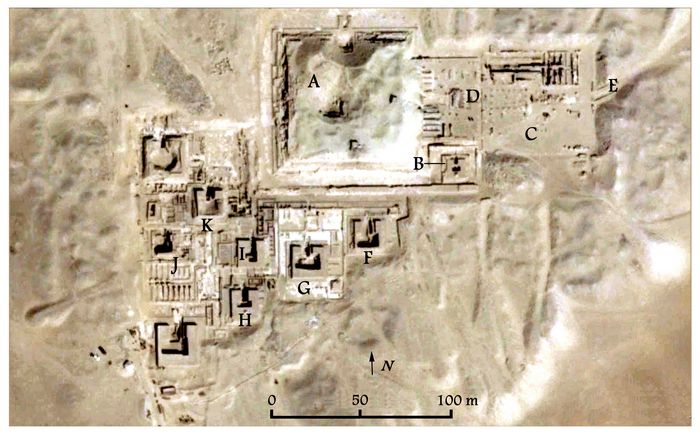Athena Review Image Archive ™
Saqqara: Pyramid complex of Pepi I
.
.

The sixth Dynasty burial complex of Pepi I (Google Earth).
The pyramid of Pepi I [A], of which little now remains, dates from the 6th Dynasty. It is flanked on the east by its mortuary temple [C], and a small cult pyramid [B], and on the south and west by several other small pyramids, each with its mortuary temple. These include the Pyramids of Nebwemit [F], Inenek-Inti [G], and Meretites [H]; the Southwest Pyramid [I]; and the Pyramids of Ankhesenpepi II [K] and Ankhesenpepi III [J]
The large mortuary temple of Pepi I (C) was approached by a causeway (E) leading from the valley temple in the east. Within the mortuary temple are several distinct areas, including a courtyard, chapel, and offering hall [D].
The Pyramid of Queen Nebwenet [F], built of limestone. had a small, simple mortuary temple located in front of the pyramid's east wall. The temple entrance led through a small antechamber to the burial chamber located just south of the pyramid's vertical axis and oriented east-west. No mummy was found in the burial chamber, but fragments of a pink granite sarcophagus were recovered.
The Pyramid of Queen Inenek-Inti
The pyramid of Inenek-Inti [G], another wife of Pepi I, and its mortuary temple were somewhat larger then those of Queen Nebwenet, and the complex also has its own enclosure wall. The mortuary temple was entered from the north into a small chamber that led through a courtyard to a three niche chapel-like area for statues, and then an offering hall. The pyramid itself was entered from the courtyard on the north side, where a north chapel was located.
The Pyramid of Meritites [H], described as both a daughter of the king and wife of the king, lies south of the Southwestern Pyramid. Little else is known of Meritites.
The Southwestern Pyramid [I] may have belonged to a still unidentified queen. Little of its mortuary temple remains. A number of relief fragments were found within the ruins, portraying scenes of processions of courtiers, mortuary estates, and a fragment of a cartouche containing the name of Pepi I. The burial chamber sits on the pyramid's vertical axis, and the small adjoining room to the south of the burial chamber contained two rolls of fine linen, a gilded wooden sandal and copper utensils. Fragments of a pink granite sarcophagus were found within the burial chamber, along with wooden weights used in weaving, copper fishhooks, and large vessels made of fired clay.
The Pyramid of Ankhesenpepi III [J] was discovered near the southwest corner of the king's pyramid. In the badly damaged burial chamber, a granite arcophagus was found cut from a huge sandstone block and embedded in the floor. The lid of the sarcophagus was formed from a huge roughly dressed block of pink granite.While Ankhnesmerire I and II married Pepi I, the role of Ankhesenpepi III is still uncertain.
The Pyramid of Ankhesenpepi II [K] represents the younger sister of Ankhnesmerire I and the mother of the King, Pepi II. He was probably a regent for her young son when he took the throne Her burial chambers contain the pyramid text engraved in relief and painted green. the onlhy other tomb beside that of Pepi I's pyramid that contains such text.
Athena Review Image Archive™ back issues
Copyright © 1996-2016 Athena Publications, Inc. (All Rights Reserved).
Copyright © 2017 Rust Family Foundation